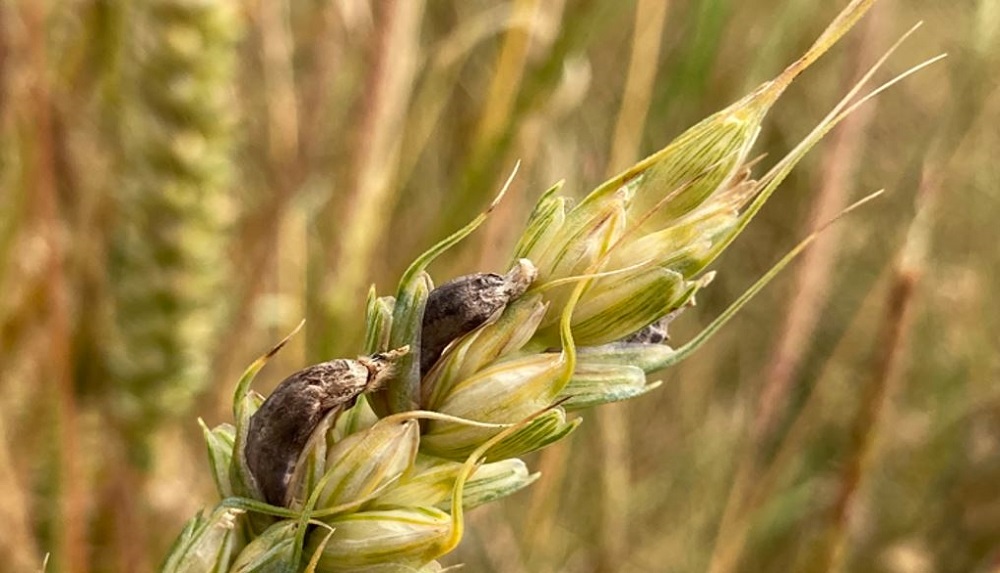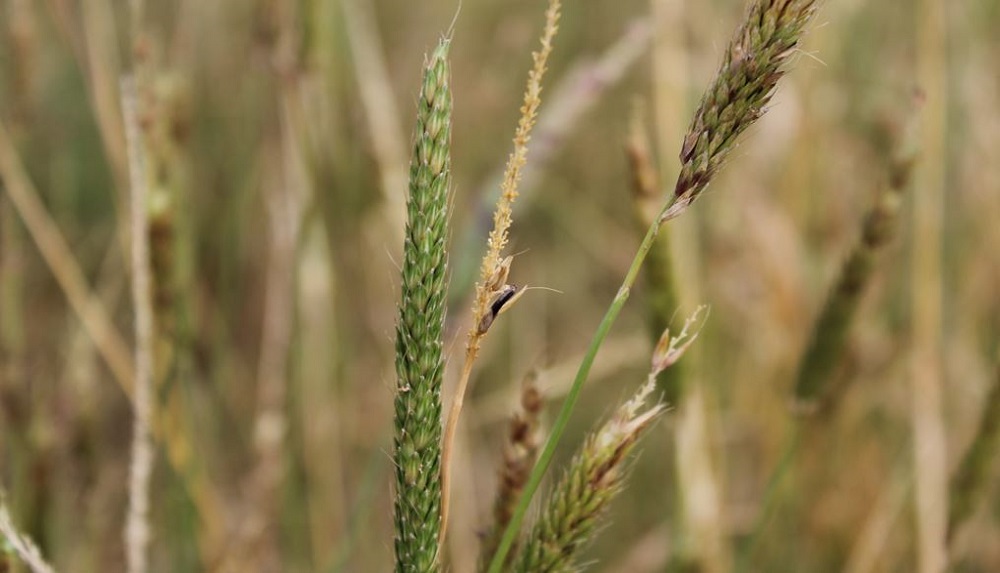An introduction to ergot and its management in cereals
Although the disease has relatively little effect on yield, ergots are associated with large amounts of toxic alkaloids (mycotoxins). A good understanding of the pathogen’s life cycle and the risk to cereal crops forms the foundation of management.
Why is it important to manage ergot in cereals?
The disease has very little direct effect on yield but the ergots contain large amounts of toxic alkaloids (mycotoxins). Contaminated grain, fed to stock or used to make flour, can pose a risk to animal and human health. Such grain may be rejected, require cleaning or demand a reduced price.
Certified seed
There are standards for the number of ergot pieces for certified seed (visual inspection):
- Up to three pieces per 500g (regulatory minimum standard)
- One piece per 1000g (higher voluntary standard)
Traded grain
Maximum legal limits: GB (England, Scotland and Wales)
Food: Under GB Assimilated Law EU 1881/2006 – 0.5g/kg Maximum Level (ML) for ergot sclerotia in unprocessed cereal, with the exception of corn and rice. There are no MLs for ergot alkaloids.
Animal Feed: Feed materials and compound feed containing unground cereals – 1g/kg ML for rye ergot sclerotia (source).
Maximum legal limits: EU
Food: The EU recently revised the limits for ergot sclerotia and alkaloids, which applied from 1 January 2022. These are not in GB-retained EU law, although adoption is due to be considered. The EU maximum levels (MLs), which already apply in Northern Ireland, are as follows.
Ergot sclerotia ML is 0.2 g/kg in unprocessed cereals, except for maize, rye and rice. Ergot sclerotia ML in unprocessed rye is 0.5g/kg (until 1 July 2025)
Ergot alkaloids MLs for cereals and milling products of barley, wheat, spelt, and oats are:
- For ash content lower than 900 mg/100 g (e.g. white flour) is 50 μg/kg from 1 July 2024
- For ash content equal to or higher than 900 mg/100 g (e.g. wholemeal flour) is 150 μg/kg
- The ML for barley, wheat, spelt and oats grains placed on the market for the final consumer is 150 μg/kg
- The ML for processed cereal-based food for infants and young children is 20 μg/kg
Animal Feed: The ML for rye ergot sclerotia is 1g/kg in feed materials and compound feed containing unground cereals.
Grain contracts
It is essential to know what contract is being used and that it is based on clear terms. Before signing the contract, negotiate, establish and accept all terms. Grain buyers are obliged to make available the terms and conditions on which the contract is made.
The approved AIC Contract for Grains/Pulses states that: “grain shall not contain more than 0.001% ergot by weight for feed grain and zero tolerance for all other grain.”
The maximum levels for ergot sclerotia are currently defined within the Codex standards at a level of 0.05%.
Fluctuating risk
The increased scientific understanding and improvements in agricultural practices and milling techniques (grading, sieving and sorting) have eliminated the severe epidemic outbreaks of ergotism in the UK. There are year-to-year fluctuations in ergot severity that can be explained, to some extent, by variations in weather during flowering.
Management of ergot in cereal crops
Which cereal crops are most susceptible?
There are a several strains of the fungus: some infect grasses and cereals, whereas others are restricted to specific hosts.
In order of decreasing susceptibility, the disease affects rye, triticale, wheat, barley and oats (infection of oats is rare). It also affects a wide range of grasses, particularly black-grass.
The disease is favoured by cool, wet conditions during flowering which facilitate spore production and prolong the flowering period, making infection more likely. Late tillering crops and crops with secondary tillers are more susceptible.
High-risk factors
- Open pollinated wheat varieties
- Varieties with a long flowering period
- Cool and wet conditions during flowering, which facilitates spore production and prolongs the flowering period
- Grassweeds, particularly black-grass
- Grass margins containing early flowering grass species
- Late and secondary tillering
Ergot life cycle and symptoms in cereals
Caused by Claviceps purpurea, ergot is not a true seed-borne disease, as it is not carried on or in seed. However, it can be spread by ergots in contaminated seed. It is also one of only two diseases included in the UK Seed Certification Scheme for Cereals (the other being loose smut).
At or near to harvest, ergots fall to the ground where they remain dormant. In the following spring, they germinate and produce mushroom-shaped spore bearing structures (stroma).
The spores are spread by the wind to nearby open flowers of grasses and cereals. The spores germinate in the flower, infecting the ovaries. This infection leads to the production of secondary spores (conidia) encased in a sweet-smelling, sticky secretion – commonly referred to as honeydew – which can lead to the development of saprophytic moulds.
Honeydew symptoms
 on developing ears.JPG) AHDB
AHDB
The honeydew attracts insects that carry the spores to other flowers, where further infection can occur. Rain splash and physical contact can also spread the spores. The fungus then grows in place of the grain to form hard, purple-black sclerotium, known as an ergot.
Ergots are formed of a mass of fungal tissue and have a white interior. Ergots can be very large, up to 2 cm in length, and are very obvious in the standing crop and in contaminated grain samples.
Ergots are either harvested with the grain or fall to the ground where they remain as a source of inoculum for the following year. Generally, ergots only remain viable on the soil surface for one year in the absence of host crops, but they may survive longer in stored grain.
Ergot (purple-black sclerotium) in a developing ear
 AHDB (Kristina Grenz)
AHDB (Kristina Grenz)
Ergot in a grass weed
 AHDB (Kristina Grenz)
AHDB (Kristina Grenz)
Ergot in a sample of grain
.JPG) AHDB
AHDB
Ergot life cycle
.JPG) AHDB
AHDB
Ergot research
How ergot alkaloids can move to apparently ‘clean’ grain has been revealed by our research. Mycotoxins appear to move between flowers and can be detected in grain that appears clear of infection. It was also found that broken ergot sclerotia in harvested grain can be a potentially significant contamination source.
Determining the routes of transmission of ergot alkaloids in cereal grains
Further information
Ergot in harvest 2024 cereals: A pathologist’s paradise (2024 blog)
Cereal disease management homepage
In this video, Joe Brennan, UK Flour Millers, discusses ergot. The cereal disease has little direct effect on yield but the ergots contain large amounts of toxic alkaloids (mycotoxins). Contaminated grain, fed to stock or used to make flour, can pose a risk to animal and human health. Such grain may be rejected, require cleaning or demand a reduced price.
With a focus on wheat, Joe provides an overview of the ergot challenge, including why it matters to millers and what farmers can do to manage the disease.
Ergot in UK cereal crops and changing legislation (2022 blog)
Contaminants monitoring
Agrochemical residues, mycotoxins and other major contaminants in cereals and co-products have been monitored independently since the mid-1980s. Find out about our research that aims to help ensure the safety of UK grain and its end products.
Monitoring of contaminants in UK cereals used for processing food and animal feed

